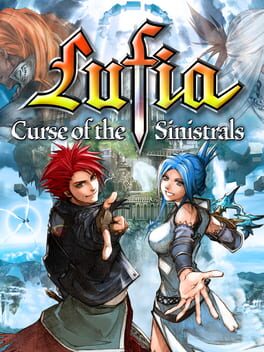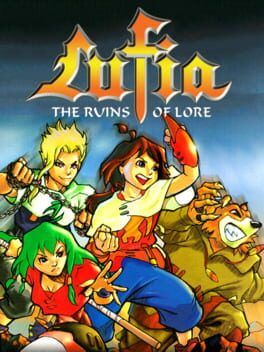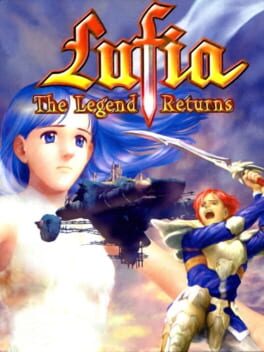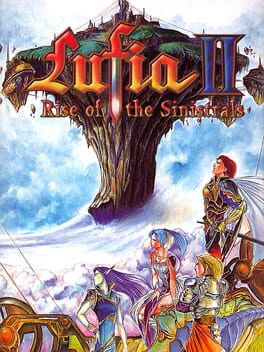

The Sinsitrals, four masters of Doom, arrived in this land on their floating island 100 years ago. You will begin your quest by travelling through time to join in a temendous battle against them--and you will determine the outcome. When you return to present time, you and Lufia, your companion, must join forces with two others to prevent the Sinistrals from regaining control of your world. It will be a long and difficult task--This land is larger than that of most RPG games. And in the end, the balance of fate will be overturned in a contest of love and betrayal that could destroy you all.
Also in series
Reviews View More
Played using the "Lufia & The Fortress of Doom Restored" romhack. It provided much appreciated QoL such as faster walk speeds, nerfs for the infamously aggressive encounter rate, descriptions for items, and the ability for certain characters to use powerful equipment they weren't allowed to before. Initially, I was worried that last thing would make the game too easy and offset the intended difficulty balance, but after beating it, I wouldn't worry. This is still a very faithful way to experience the game, and these sorts of balancing changes affect only one small late-game aspect of this near-30 hour adventure. As a whole, you're playing Lufia as intended. And that... may be the real problem.
The overall QoL from this romhack made Lufia into a tolerable experience, but... tolerable is pretty much the highest it ever goes. I wouldn't be so ridiculous as to say it's the worst RPG I've played, but even calling it "decent" makes my expression skeeve into a skeptical gritting of teeth, accompanied by a dog-like head tilt. Lufia 1 is the embodiment of chasing a trend in the 90's, about on par with Breath of Fire's attempt in the same year. The most cookie-cutter Dragon Quest clone you could think of. It's uninspired, uncreative, undesiring of doing anything of its own without looking over at its competitors for their fatherly approval over what makes an RPG, while never asking itself "What COULD make an RPG?"
Edit: Reading up a little further on the history of Lufia 1, it's at least worth noting that this was a rare case of a major SNES RPG that actually made it over to the west, in a time where games like Dragon Quest V and Final Fantasy V didn't make it outside Japan due to the genre being seen as a non-profitable niche. To many westerners playing it at the time, it's likely that Lufia didn't feel like a clone of anything, and thus felt quite special. As for me, I have had the chance to experience DQ5 & FF5 beforehand, hence my review was written with that sort of perspective. In a modern age, where you have access to all regions and there's no such thing as an "elusive japan-exclusive" game, Lufia does not carry the magic that it may have carried 30 years ago. Anyway, let's move on.
To its credit, of all the notes Lufia could take, it at least gets close to an engaging combat system. Enemies are no push-overs, and are capable of putting a serious dent in your party. There were plenty occasions where I felt encouraged to experiment with my expanding arsenal of spells, and felt rewarded for taking advantage of certain weaknesses, or developing basic strategies to overcome bosses. Over the course of each encounter with the regular enemies, you quickly learn which ones are more dangerous than others, and you start to actively prioritize getting rid of them as soon as possible.
In addition, Lufia 1 makes the decision to omit auto-targeting. So, if you target one enemy with two party members, but the first party member takes them out, the second member will end up hitting nothing. At first, this seemed like a baffling decision that was antiquated even in the year it came out in, but, I... actually grew to appreciate the element of strategy that this further added into the battles. You can't just mash attack in this game, the efficient way to play is to assign each of your members into specific groups of enemies based on how many you think it'll take to kill each enemy. Sometimes, this even puts the element of risk into the equation. Like, it may take one hit from this party member to kill this enemy, but there's a chance it may take two, so do you want to assign two party members onto this enemy and risk wasting one of them, or should you put them into a different enemy instead? Combine that with the aforementioned prioritizing of more dangerous enemies, and Lufia's combat is... again, to its credit, not mindless!
But even with this saggy ace in its water-soaked sleeve, Lufia is still a very grindy game at its core, and my appreciation for its combat was worn down before I even got halfway through. All that was left then, was everything else, and that might as well mean fuck all. The music? It's whatever. The variety? There is none. There are exactly four types of areas to be found: Grassy town, cave, tower, and castle. Though at one point the game pulls out an underwater cave, and the change in scenery almost made me rocket up into the sky and explode like a firework. And then it was back to those four types of areas for the rest of it. All of them sharing the same music, the same appearance, the same treasure chest hunting loop. Just a rearranged layout and a different color palette being the main difference amongst these approx. 100-150 boring-ass locales.
I don't exactly hold the story in any higher regard, though one thing that confuses me is I've seen at least two instances of the dialogue/localization being called laughably bad, and, I don't... see it? In fact, the localization looks to be perfectly servicable, clearly translated by an english-speaking guy. Is the case that the translation took out important pieces of dialogue out of the script and removed nuance that was originally there in the japanese version? Going through the story, I can't say anything felt missing, or out of place, but perhaps there's more to this than I'm aware of.
But, as far as nuance goes, yeah, there's just none to take away from this. Your main character's a bit of a clueless bumbler, Aguro & Jerin are just in it for the ride, while Lufia, the titular character, for all the importance she's given, can underwhelmingly be summed up as little more but a stereotype. She fights well alongside you, which is the one neat thing, but boy howdy does she love flowers, and shopping, and baking pies, and yowie, will she get jealous and competitive when you show concern for a half-elf with a kid's psychique- wait, what the fuck?
There was only one reason I bothered playing Lufia 1 at all. And much like the age-old question of "Why did the chicken cross the road," here too my reasoning is "to get to the other side." And on the other side, lies Lufia 2, the holy grail. It's the one game that everybody familiar with the Lufia franchise recommends, for some curious reason. Whether playing Lufia 1 or not is paramount to understand the continuity of its sequel - if there is a continuity - is a question I've yet to have an answer for, but I figured I'd cover the bases. Perhaps remind me after I beat Lufia 2, to update this review and answer whether playing this first game was worth it at all. But for now, something tells me, no. No, it was not. The process of forgetting everything about Lufia & The Fortress of Doom, begins... now.
My results screen
The overall QoL from this romhack made Lufia into a tolerable experience, but... tolerable is pretty much the highest it ever goes. I wouldn't be so ridiculous as to say it's the worst RPG I've played, but even calling it "decent" makes my expression skeeve into a skeptical gritting of teeth, accompanied by a dog-like head tilt. Lufia 1 is the embodiment of chasing a trend in the 90's, about on par with Breath of Fire's attempt in the same year. The most cookie-cutter Dragon Quest clone you could think of. It's uninspired, uncreative, undesiring of doing anything of its own without looking over at its competitors for their fatherly approval over what makes an RPG, while never asking itself "What COULD make an RPG?"
Edit: Reading up a little further on the history of Lufia 1, it's at least worth noting that this was a rare case of a major SNES RPG that actually made it over to the west, in a time where games like Dragon Quest V and Final Fantasy V didn't make it outside Japan due to the genre being seen as a non-profitable niche. To many westerners playing it at the time, it's likely that Lufia didn't feel like a clone of anything, and thus felt quite special. As for me, I have had the chance to experience DQ5 & FF5 beforehand, hence my review was written with that sort of perspective. In a modern age, where you have access to all regions and there's no such thing as an "elusive japan-exclusive" game, Lufia does not carry the magic that it may have carried 30 years ago. Anyway, let's move on.
To its credit, of all the notes Lufia could take, it at least gets close to an engaging combat system. Enemies are no push-overs, and are capable of putting a serious dent in your party. There were plenty occasions where I felt encouraged to experiment with my expanding arsenal of spells, and felt rewarded for taking advantage of certain weaknesses, or developing basic strategies to overcome bosses. Over the course of each encounter with the regular enemies, you quickly learn which ones are more dangerous than others, and you start to actively prioritize getting rid of them as soon as possible.
In addition, Lufia 1 makes the decision to omit auto-targeting. So, if you target one enemy with two party members, but the first party member takes them out, the second member will end up hitting nothing. At first, this seemed like a baffling decision that was antiquated even in the year it came out in, but, I... actually grew to appreciate the element of strategy that this further added into the battles. You can't just mash attack in this game, the efficient way to play is to assign each of your members into specific groups of enemies based on how many you think it'll take to kill each enemy. Sometimes, this even puts the element of risk into the equation. Like, it may take one hit from this party member to kill this enemy, but there's a chance it may take two, so do you want to assign two party members onto this enemy and risk wasting one of them, or should you put them into a different enemy instead? Combine that with the aforementioned prioritizing of more dangerous enemies, and Lufia's combat is... again, to its credit, not mindless!
But even with this saggy ace in its water-soaked sleeve, Lufia is still a very grindy game at its core, and my appreciation for its combat was worn down before I even got halfway through. All that was left then, was everything else, and that might as well mean fuck all. The music? It's whatever. The variety? There is none. There are exactly four types of areas to be found: Grassy town, cave, tower, and castle. Though at one point the game pulls out an underwater cave, and the change in scenery almost made me rocket up into the sky and explode like a firework. And then it was back to those four types of areas for the rest of it. All of them sharing the same music, the same appearance, the same treasure chest hunting loop. Just a rearranged layout and a different color palette being the main difference amongst these approx. 100-150 boring-ass locales.
I don't exactly hold the story in any higher regard, though one thing that confuses me is I've seen at least two instances of the dialogue/localization being called laughably bad, and, I don't... see it? In fact, the localization looks to be perfectly servicable, clearly translated by an english-speaking guy. Is the case that the translation took out important pieces of dialogue out of the script and removed nuance that was originally there in the japanese version? Going through the story, I can't say anything felt missing, or out of place, but perhaps there's more to this than I'm aware of.
But, as far as nuance goes, yeah, there's just none to take away from this. Your main character's a bit of a clueless bumbler, Aguro & Jerin are just in it for the ride, while Lufia, the titular character, for all the importance she's given, can underwhelmingly be summed up as little more but a stereotype. She fights well alongside you, which is the one neat thing, but boy howdy does she love flowers, and shopping, and baking pies, and yowie, will she get jealous and competitive when you show concern for a half-elf with a kid's psychique- wait, what the fuck?
There was only one reason I bothered playing Lufia 1 at all. And much like the age-old question of "Why did the chicken cross the road," here too my reasoning is "to get to the other side." And on the other side, lies Lufia 2, the holy grail. It's the one game that everybody familiar with the Lufia franchise recommends, for some curious reason. Whether playing Lufia 1 or not is paramount to understand the continuity of its sequel - if there is a continuity - is a question I've yet to have an answer for, but I figured I'd cover the bases. Perhaps remind me after I beat Lufia 2, to update this review and answer whether playing this first game was worth it at all. But for now, something tells me, no. No, it was not. The process of forgetting everything about Lufia & The Fortress of Doom, begins... now.
My results screen
This was my favorite childhood game. I played it many times in the 1990s, and I even used my cassette deck to record music from the game onto tapes so that I could listen to it on my walkman. The story is simple but also has some feeling to it. There are bits that make me laugh out loud and feel sad.
This particular replay was the "Restored" version that can be found on romhacking.net, although the item descriptions never showed for me. It was nice to be able to move faster on the world map and in dungeons, and the reduced encounter rate was also nice. It had probably been 30 years since I played this, so I can't say how much different it is, but very enjoyable changes to what was a fairly easy game to start with.
This particular replay was the "Restored" version that can be found on romhacking.net, although the item descriptions never showed for me. It was nice to be able to move faster on the world map and in dungeons, and the reduced encounter rate was also nice. It had probably been 30 years since I played this, so I can't say how much different it is, but very enjoyable changes to what was a fairly easy game to start with.




